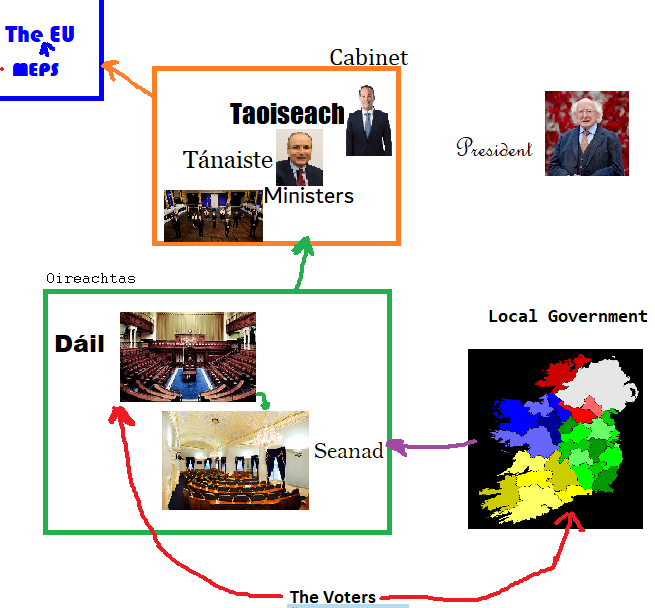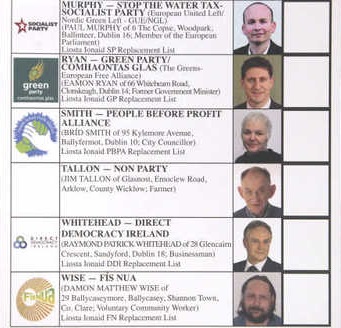What is All This?
Explaining the Irish Political Scene.
If you go on to any of my other pages you're probably terrified by the weird names and colours I've suddenly thrown at you: Why are there so many parties? What the hell is this tee-shock? What's with everone being the colour green? So like who's the democrat and who's the republican? Do ye have a president?
If you sound like this, this page is where you should probably start. I'll give you a rundown of the structure of things as a whole, parties to watch out for and other bits and bobs.
The Basic Basics.

The most important person in Irish politics is pretty much always the Taoiseach. This is our head of state and is about equivalent to most other countries Prime Ministers. However if you call the Taoiseach the Prime Minister you will be laughed at (even though you're not fully wrong. The current Taoiseach is Micheál Martin (pictured in the graph) who is the leader of Fianna Fáil. Taoisigh (plural for Taoiseach) are also normally always the leader of their party, unsurprisingly.
Playing second fiddle to the Taoiseach is the Tánaiste, who is roughly equivalent to a deputy prime minister. In practice this role is mostly ceremonial but this person is also normally the leader of the next biggest party in government so they actually have a good amount of sway. Normally a Tánaiste is also a minister (we'll get to them). For instance, the present Tánaiste is Simon Harris, who is the leader of Fine Gael and also our Minister for Defence, Foreign Affairs and Trade.
The next big role to pay attention to are the aforementioned ministers. Ministers have a specific policy area and are given a government department to manage. The Irish government is limited to 15 ministers (but not 15 departments so some of them can do two jobs at once). Ministers are the most important people in a government and the jobs are divided between government parties. Examples of their policy areas would be: Education, Health, Finance, or Housing. Together with the Taoiseach, we call this the cabinet.
All of these people are elected with majority support from the Houses of the Oireachtas, which is the next step down. The oireachtas can be understood as the parliament with two bodies within it, the Dáil and the Seanad. Of these, we will focus on the Dáil since the Seanad is convoluted and ultimately unimportant. All ministers and the Taoiseach must be members of the Dáil (members of the Dáil are called TDs for short). The Dáil is elected directly by the public every 4 or so years and is at the heart of Irish politics.
Finally, you'll also notice on this graph that we do in fact have a president (currently the delightful Michael D. Higgins). This position is purely a figurehead position and their main job involves shaking hands and meeting with other heads of states. (The role was created largely to mimic the role played by the monarchy in a country like Britain or Spain).
Voting!
Every country votes differently and we vote quite differently altogether. Our system (which I do think is one of the best systems) is called Single Transferable Vote and it is only used by one other country in the world: Malta. If you're a nerd like me, the short jargon explanation is that it is a "Multi-Member Ranked Choice System" but I'll be clearer than that.
When you go to vote in Ireland, your ballot will look something like this:

(There are normally more names).
When you go to vote, you simply rank the canidates from 1st to last (or as far down as you want) on the paper and then go home. However the interesting part happens after this.
The entire country is divided into different constituencies (there are currently 43) with each constituency being assigned between 3 and 5 seats. So on election night, when ballots are being counted, a quota is set of how many votes a candidate needs to win any one of these seats. (Normally its the number of votes divided by the number of seats, though we use a more complicated system I won't detail here). If candidate A meets the quota, then for every vote they receive after this (called a surplus vote), rather than simply ignoring these votes (shoulda voted tactically), we look at who they would have voted for if A wasn't running (or as it were, if they knew A would win regardless) and as such, we look at their number 2 votes and add them onto that candidate's support. If nobody reaches the quota, instead we look a the worst performing candidate and imagine a world where they never ran (we eliminate them). To do this, again we look at their voters' number 2 choice and give them to that candidate instead. We keep doing this until either every candidate reaches the quota, or until there are as many candidates left as there are seats in the constituency. (You can find a sample election down the bottom of this page).
This system means that while the individual candidates themselves still matter, we can also guarantee that smaller parties and independents get represented at a national level especially when compared to a first-past-the-post system.
The Parties
For a thorough rundown, please look here! [link not yet added]. However, I'll give you a brief picture here to work with.
Ireland has generally had two main parties: Fianna Fáil and Fine Gael, most people really struggle to tell the difference between them (academics included). In the quickest way, yes they are mostly the same on everything but Fianna Fáil is slightly more pro-government spending than Fine Gael and somewhat more conservative than them as well. Both parties are wide though so you will find individuals all over the spectrum within them, if you're voting, maybe look into your local candidates for them. Outside of the big two, the new kid on the block (and one of the oldest kids on the block) is Sinn Féin. Sinn Féin are big on reunification and Irishness writ large (language & culture). They are left-wing and want the state to step in with regards to the housing crisis etc, though some people are still pretty scared about their old ties to the IRA. Outside of them, we have 4 different smaller left-wing parties ( listed from moderate to cool), namely the Greens, Labour, the Social Democrats, & People Before Profit/Solidarity. We also have 2 conservative parties in the form of Independent Ireland and Aontú. On top of all this, we have a very high number of independents who each bring their own convictions to the Dáil (although these tend to lean right on average).
The Seanad.
Again, this is a brief explanation, click [here] for the full picture.
Paired with the Dáil, the Seanad acts as our second house of parliament. Depending on your convictions it is either a "Retirement home for useless politicians" or an "advisory body of professionals designed to scrutinize legislation further than the Dáil could". The truth is somewhere in the middle. The Seanad can delay bills and introduce new bills but they don't have the power to override the Dáil in any case. They work very similarly to the Dáil on a day to day basis with a cathaoirleach, leader, etc.
You probably don't remember ever voting in the Seanad though, because you don't. The Seanad is elected by elected representatives across the country (namely local councillors, TDs, MEPs, & outgoing Senators). This means the Seanad generally looks more similar to the local election results than the Dáil results.
This is probably a benefit beacuse the Seanad elections are complicated enough to make you not want to be able to vote in them. The 60 seats of the Seanad are elected from 3 different routes. The easiest to understand of these are the 11 Senators that are directly appointed by the Taoiseach. This is to make sure that the Dáil majority will always match a Seanad majority (so as not to bother the government too much), though it also has a benefit in letting the Taoiseach reward loyal politicians who don't manage to win their elections in either the Seanad or Dáil. 6 Senators are elected from University Panels, where only graduates from specific universities are entitled to vote. This may strike you as elitist and exclusionary, however... That is exactly true. 3 of these Senators are specifically elected by graduates from Trinity College Dublin while the other 3 are shared between the NUI universities (UCC, UCD, UCG, Maynooth, RCSI, and the IPA). If you graduated from any other College, that was your mistake.
The bulk of Senators (43) are elected from 5 Vocational Panels, corresponding to various sectors (ie Administrative, Agricultural, Labour, etc). Each panel hosts a seperate election with each elected rep casting their vote in each panel. To get nominated for the election, candidates have two main routes: the internal path & the external path. The internal path required you to be nominated
Extras
The Droop Quota
A Sample Election
